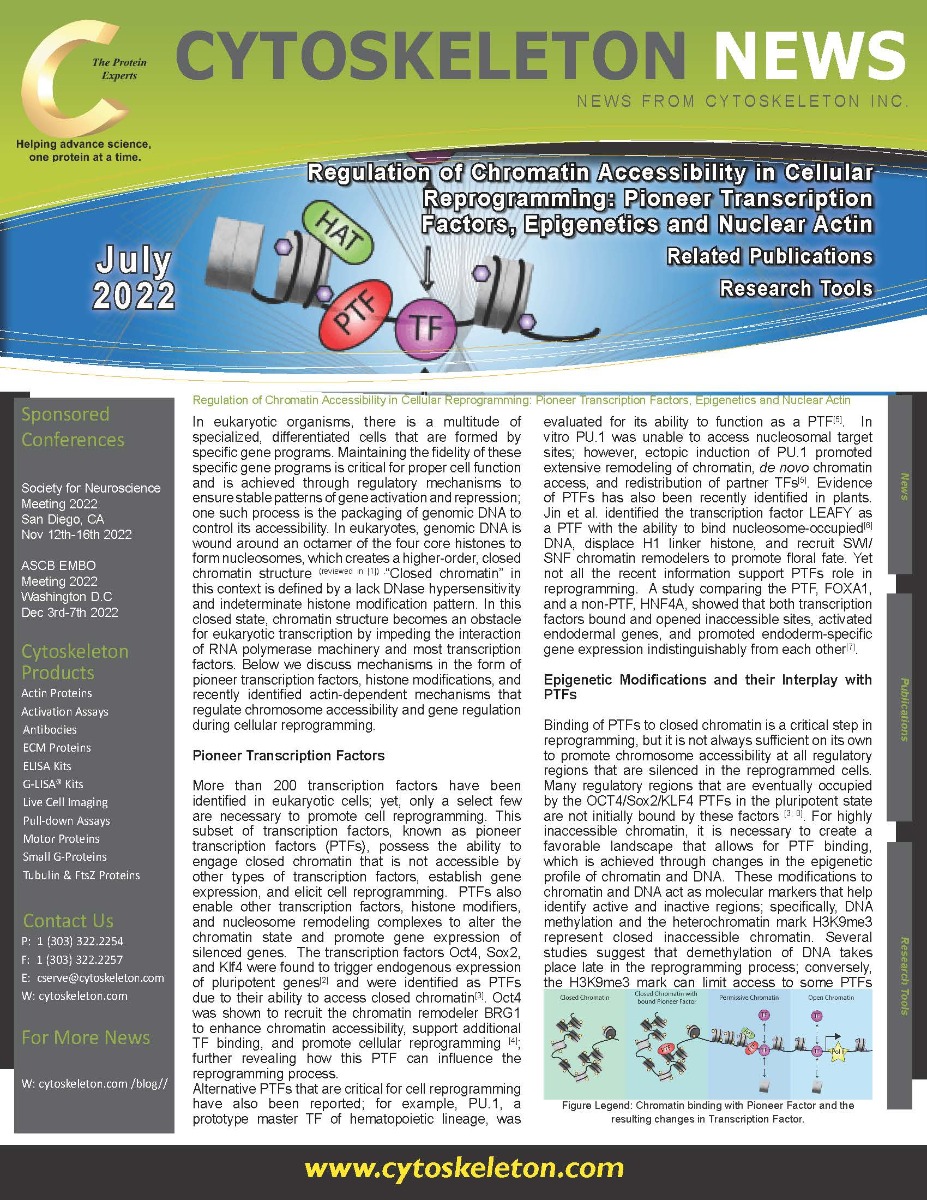Regulation of Chromatin Accessibility in Cellular Reprogramming: Pioneer Transcription Factors, Epigenetics and Nuclear Actin
Introduction
In eukaryotic organisms, there is a multitude of specialized, differentiated cells that are formed by specific gene programs. Maintaining the fidelity of these specific gene programs is critical for proper cell function and is achieved through regulatory mechanisms to ensure stable patterns of gene activation and repression; one such process is the packaging of genomic DNA to control its accessibility. In eukaryotes, genomic DNA is wound around an octamer of the four core histones to form nucleosomes, which creates a higher-order, closed chromatin structure (reviewed in [1]) .“Closed chromatin” in this context is defined by a lack DNase hypersensitivity and indeterminate histone modification pattern. In this closed state, chromatin structure becomes an obstacle for eukaryotic transcription by impeding the interaction of RNA polymerase machinery and most transcription factors (TFs). Below we discuss mechanisms in the form of pioneer transcription factors, histone modifications, and recently identified actin-dependent mechanisms that regulate chromosome accessibility and gene regulation during cellular reprogramming.

Above: Pioneer transcription factors bind closed chromatin to enhance accessibility for other transcription factors and epigenetic-regulatory proteins
References
- Kornberg, R.D. and Y. Lorch, Twenty-five years of the nucleosome, fundamental particle of the eukaryote chromosome. Cell, 1999. 98(3): p. 285-94.
- Takahashi, K. and S. Yamanaka, Induction of pluripotent stem cells from mouse embryonic and adult fibroblast cultures by defined factors. Cell, 2006. 126(4): p. 663-76.
- Soufi, A., G. Donahue, and K.S. Zaret, Facilitators and impediments of the pluripotency reprogramming factors' initial engagement with the genome. Cell, 2012. 151(5): p. 994-1004.
- King, H.W. and R.J. Klose, The pioneer factor OCT4 requires the chromatin remodeller BRG1 to support gene regulatory element function in mouse embryonic stem cells. Elife, 2017. 6.
- Minderjahn, J., et al., Mechanisms governing the pioneering and redistribution capabilities of the non-classical pioneer PU.1. Nat Commun, 2020. 11(1): p. 402.
- Jin, R., et al., LEAFY is a pioneer transcription factor and licenses cell reprogramming to floral fate. Nat Commun, 2021. 12(1): p. 626.
- Hansen, J.L., K.J. Loell, and B.A. Cohen, A test of the pioneer factor hypothesis using ectopic liver gene activation. Elife, 2022. 11.
- Sridharan, R., et al., Role of the murine reprogramming factors in the induction of pluripotency. Cell, 2009. 136(2): p. 364-77.
- Li, D., et al., Chromatin accessibility dynamics during cell fate reprogramming. EMBO Rep, 2021. 22(2): p. e51644.
- Adachi, K., et al., Esrrb Unlocks Silenced Enhancers for Reprogramming to Naive Pluripotency. Cell Stem Cell, 2018. 23(6): p. 900-904.
- Mikkelsen, T.S., et al., Dissecting direct reprogramming through integrative genomic analysis. Nature, 2008. 454(7200): p. 49-55.
- Bannister, A.J. and T. Kouzarides, Regulation of chromatin by histone modifications. Cell Res, 2011. 21(3): p. 381-95.
- Cary, P.D., et al., Effect of acetylation on the binding of N-terminal peptides of histone H4 to DNA. Eur J Biochem, 1982. 127(1): p. 137-43.
- Tse, C., et al., Disruption of higher-order folding by core histone acetylation dramatically enhances transcription of nucleosomal arrays by RNA polymerase III. Mol Cell Biol, 1998. 18(8): p. 4629-38.
- Hebbes, T.R., et al., Core histone hyperacetylation co-maps with generalized DNase I sensitivity in the chicken beta-globin chromosomal domain. EMBO J, 1994. 13(8): p. 1823-30.
- Miao, L., et al., The landscape of pioneer factor activity reveals the mechanisms of chromatin reprogramming and genome activation. Mol Cell, 2022. 82(5): p. 986-1002 e9.
- Misu, S., M. Takebayashi, and K. Miyamoto, Nuclear Actin in Development and Transcriptional Reprogramming. Front Genet, 2017. 8: p. 27.
- Kapoor, P. and X. Shen, Mechanisms of nuclear actin in chromatin-remodeling complexes. Trends Cell Biol, 2014. 24(4): p. 238-46.
- Visa, N. and P. Percipalle, Nuclear functions of actin. Cold Spring Harb Perspect Biol, 2010. 2(4): p. a000620.
- Miyamoto, K., et al., Nuclear actin polymerization is required for transcriptional reprogramming of Oct4 by oocytes. Genes Dev, 2011. 25(9): p. 946-58.
- Miyamoto, K., et al., Nuclear Wave1 is required for reprogramming transcription in oocytes and for normal development. Science, 2013. 341(6149): p. 1002-5.
- Yamazaki, S., et al., Nuclear actin activates human transcription factor genes including the OCT4 gene. Biosci Biotechnol Biochem, 2015. 79(2): p. 242-6.
- Hu, X., et al., MKL1-actin pathway restricts chromatin accessibility and prevents mature pluripotency activation. Nat Commun, 2019. 10(1): p. 1695.
- Al-Sayegh, M.A., et al., beta-actin contributes to open chromatin for activation of the adipogenic pioneer factor CEBPA during transcriptional reprograming. Mol Biol Cell, 2020. 31(23): p. 2511-2521.

